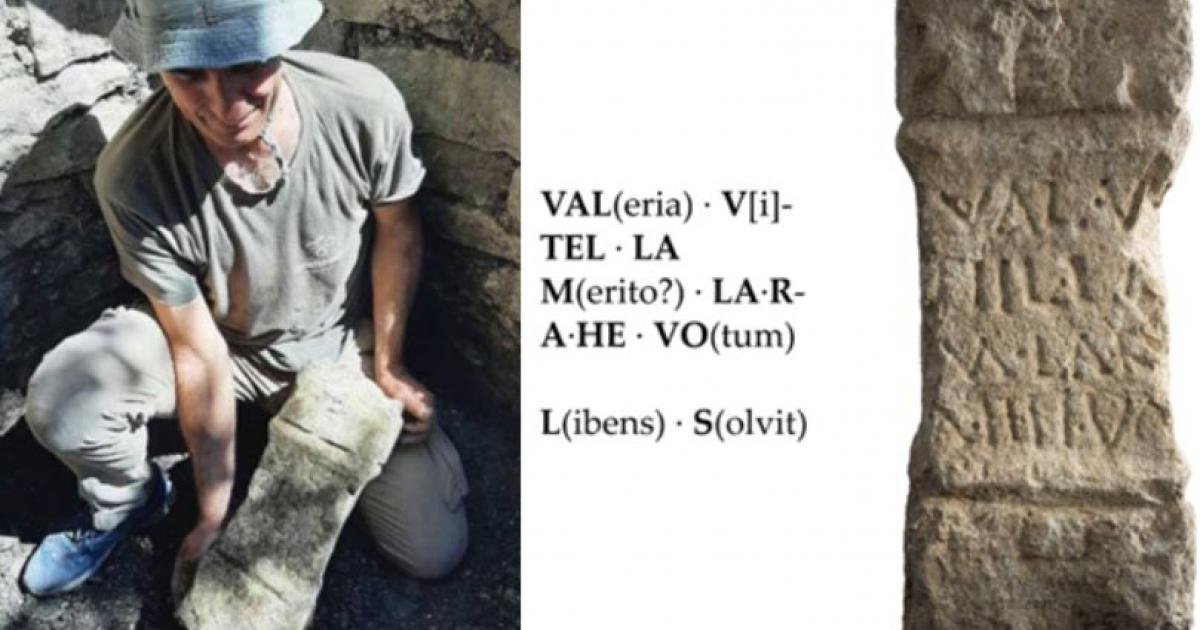
1st Century Votive Altar on Spain’s Mount Arriaundi Honors Vascon Deity
1st Century Votive Altar on Spain’s Mount Arriaundi Honors Vascon Deity
In August 2022, a team of researchers and university faculty unearthed a Roman-era votive altar in Larunbe, Navarra, while excavating the 11th century medieval monastery of Doneztebe. This altar, dating back to the 1st century AD, features a Latin dedication by a woman named Valeria Vitella to the ancient Basque and Vascon deity, Larra. It was discovered within a well during the archaeological excavations of the medieval monastery of Doneztebe on Mount Arriaundi.
- Bronze Hand Inscribed with Rare Vasconic Script Linked With Basque Found in Spain
- Exploring the Mystery of the Basques (Video)
A Defensive Promontory, A Mighty Monastery?
Led by the Aranzadi Science Society, the Mount Arriaundi archaeological site has demonstrated the evolution of a cultural hub through different eras, from the Roman period to the Modern Age. Its strategic location, a defensible promontory with a commanding view of a major access route to the Pamplona basin, made it a significant and religiously important place over various periods, reports Aranzadi Zientzia elkartea.
- 40,000-Year-Old Cave Art Fills Basque Country Void
- More Than 70 Engravings and Paintings from 14,000 Years Ago Discovered in a Spanish Cave

Aerial view of the early medieval monastery of Doneztebe. (Aranzadi)
In the 11th century, the Kingdom of Pamplona established a monastery dedicated to Saint Stephen (Doneztebe) at this site. Thanks to the efforts of Larunbe residents and the archaeological coordination of Aranzadi, the remains of this monastery—retaining its original layout with three semicircular apses—were discovered and preserved. This monastery now defines the central area of the site and serves as a key reference for studying medieval religious architecture in the region.

Peio Esain inside the well, holding the votive altar. (Juantxo Agirre / Aranzadi)
The votive altar is a remarkable find, notable not only for its age but also for the insights it provides. Roman altars are typically made of stone, bearing Latin inscriptions that specify the deity and the name of the person dedicating the altar. The Larunbe altar features an inscription by Valeria Vitella, dedicating it to the Vascon (ancient Basque) deity Larra: VAL (eria)·V(i)-TEL·LA M(erito?) ·LA·R-A·HE·VO (tum) L(ibens)·S(olvit). This literally translates to Valeria Vitella fulfils her vow to Larrahe freely and deservedly.”
According to researchers, who were quoted by the LBV Magazine, “It is evidently a Vascon deity, as it has a final part written -HE which we can probably interpret as the Vascon dative form, indicating to whom it is dedicated: to the deity Larra. The Vascon name, with its connection to modern Basque, suggests interpreting it as a deity related to the field or farmland.”
Standing at the Altar: An Intentional Choice?
This altar was found at the bottom of a medieval well, with the inscription facing downwards, raising questions about whether it was thrown there or intentionally placed. Although Roman-era artifacts such as ceramic fragments and coins had been previously documented at Arriaundi, the discovery of this votive altar changes our understanding of Vascon religious practices and beliefs.
The name of the deity Larrahe has been found on only three other altars within the Vascon territory, all located in the Arga basin and its tributary, the Salado River, in Muruzabal de Andión, Irujo, and Riezu. The Larunbe altar is exceptional for being the northernmost and highest-altitude altar discovered, as well as the only one found during an archaeological intervention. This discovery broadens our knowledge of the deity's influence and provides more context about its worship and significance in the region.

Votive Altar uncovered during excavations at the medieval monastery of Doneztebe on Mount Arriaundi. (Aranzadi)
The Larunbe altar has become a vital piece for studying the Vascon language and its connections to modern Basque. The Latin inscription featuring the name Larrahe offers additional evidence on the use and evolution of the Vascon language and the territorial reach of the deity's cult, reports The Heritage Daily.
The altar was officially unveiled at the church of San Vicente de Larunbe, with notable political and academic figures in attendance. The event included the presentation of two monographs on the altar and the Arriaundi site, a documentary on the discovery, and a mural dedicated to Larrahe by muralist Iker Uribe.
According to Aranzadi: “Arriaundi constitutes an important archaeological site, since it allows us to learn about the evolution of a cultural enclave with various phases ranging from the Roman era, through Late Antiquity, and continuing practically throughout the Middle Ages to the Modern Age.”
Top image: Archaeologist holding votive altar and (right) Latin inscriptions on votive altar. Source: Juantxo Agirre / Aranzadi
By Sahir Pandey
References
Carvajal, G. 2024. 1st Century AD Votive Altar Dedicated to a Vascon Deity Unearthed in Navarre. Available at: https://www.labrujulaverde.com/en/2024/06/1st-century-ad-votive-altar-dedicated-to-a-vascon-deity-unearthed-in-navarre/.
Milligan, M. 2024. Archaeologists uncover votive altar on Mount Arriaundi. Available at: https://www.heritagedaily.com/2024/06/archaeologists-uncover-votive-altar-on-mount-arriaundi/152351.















